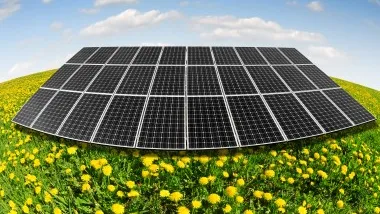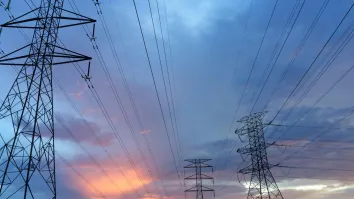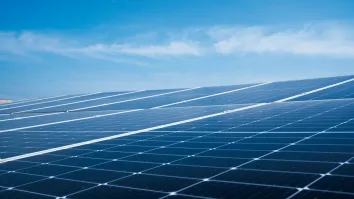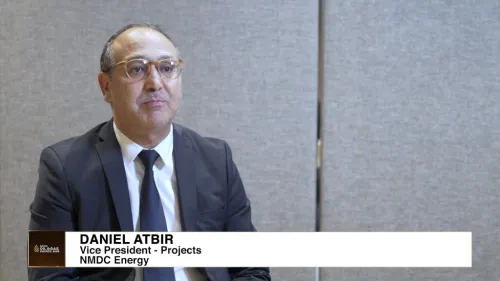
Three reasons why agrivoltaics could be key RE sector in India
Geography is a major factor why the country is best to adopt agrivoltaics, IEEFA says.
India has set its target locked on increasing the capacity of renewables to 500-gigawatts by 2050. And one sector that it could tap in its energy transition is agrivolatics or the installation of solar panels in lands used for agriculture, the the Institute for Energy Economics and Financial Analysis (IEEFA) claimed.
To back this up, IEEFA gave three reasons. The most obvious reason would be the country’s geography—the majority of India’s land area is used for farming. Second reason is that this renewable sector will address the expected increase in India’s energy demand growth and, finally, provide socio-economic opportunities, especially for the rural sector.
However, there is a need for implementation of policies that would encourage adoption of agrivoltaics such as allowing non-farming commercial activities in most states, providing incentives, and funding programmes.
Globally, agrivoltaics installed capacity has approximately grown from about 5 megawatts (MW) in 2012 to approximately 2.9GW today, led mostly by Germany, France, and Italy, whose COVID recovery plan devotes over €1b to establishing 2GW of agrivoltaic projects, said IEEFA Contributor Charles Worringham, citing reports.
There has also been an increasing number of research and empirical experience, as seen in the 2021 Agrivoltaics Conference. It is just in its second year but it has already attracted 84 abstracts and delegates from 39 countries.
In India, a joint German-Indian report has listed 16 existing installations, and has also developed a publicly accessible online map of these projects. An additional 7MW solar power project for Gro Solar Energy in Maharashtra with low-height crops between modules has been announced, and others are in various stages of development.
Even at a very early stage and composed mostly of small-scale research and demonstration projects, agrivoltaics remain relevant to India for three reasons according to IEEFA: scale and scope of electricity system growth, geographic, and socio-economic opportunities for the rural sector.
India is expected to see significant energy demand growth over the coming decades, along with the intensifying calls to accelerate clean energy transition.
The country will see a far more extensive power infrastructure growth of all types and strong incentives to build a geographically diverse and robust network, at speed. This will favour generation types that can be built quickly and at a range of scales, which could favour growth of agrivoltaics.
For the second reason, 60% of India’s land area is farmed, higher than the world average of 39%, according to World Bank data. Whilst areas such as Rajasthan offer especially high levels of generation potential, large tracts of the country are capable of producing solar power in higher quantities and more reliably than almost any European countries except Spain and Portugal.
This also presents socio-economic opportunities to the country’s rural sector. Indian cities are seeing additional growth stress due to large-scale seasonal migration of millions of rural citizens who seek work in cities for that period. As India faces declining farm size, with over 70% of rural households owning less than one hectare of land based on government data and unreliable weather, variable access to market and price instability any innovations that could strengthen the rural economy, stabilise agricultural employment and grow non-agriculture work could contribute to relieving the pressures of rapid growth on India’s cities.
Tech development
Indian conditions may favour particular types of agrivoltaic technology. A variation of special interest to India is the use of bifacial panels arrayed in widely-spaced rows, which in addition to the different generation properties explained below, reduces dust accumulation, an important aspect of maintenance, especially in more arid regions.
Vertical bifacial panel arrays, a layout being tried by India’s National Institute of Solar Energy as well as by Germany’s Next2Sun GmbH and Märladalen University in Sweden, have the property of generating maximum power in a morning and an afternoon peak, complementing the typical solar profile of midday peaking.
The late afternoon generation this configuration allows could partly relieve evening peak demand to the extent that loads can be shifted earlier, as may be possible for some residential cooling, or by reducing the time between generation and discharge of batteries, enabling more flexible charging schedules.
A research group at Lahore University of Management Sciences has undertaken extensive modelling of these layouts for relevant latitudes, suggesting high levels of generation relative to conventional configurations. If time-of-day pricing is introduced for feed-in tariffs, as well as on the consumer side, vertical bifacial arrays could be a particularly attractive option for agrivoltaics developers in India.
Meanwhile, in India, several groups have already made a strong start in research to establish the circumstances in which agrivoltaics can be viable. There are multiple variables whose individual effects and interactions have to be considered, and these are best studied by specialised research organisations.
These include the effects of different panel layouts because maximising power generation favours densely arrayed panels, whilst maximising yield requires dispersing the panels so as to prevent excessive shading.
Many other factors, especially appropriateness for different crops with varying levels of shade tolerance, interactions with soil and water conditions, maintenance tasks and costs all influence viability. Establishing their effects goes beyond agricultural and technical research, because the financial outcomes require analysis of how optimising the various trade-offs affects farmers’ incomes under different ownership and tariff regimes.
Ensuring food security
The roll-out of agrivoltaics in India cannot proceed without taking account of the need to protect food production and food producers. India accounted for 22% of the global burden of food insecurity, the highest for any country, in 2017 to 2019, it said, citing a report. Median farm size is under one hectare, with high levels of self- consumption of produce, most farm labourers owning no land, and multiple structural and market access issues confronting the sector, according to a report in the Indian Forum.
Any policies governing agrivoltaics must take account of these realities, as well as the needs of the 300 million additional citizens (still anticipated in coming decades despite recent falls in the total fertility rate), and be designed in such a way that farming livelihoods, food quality, and output are sustained.
Balancing energy production and food production is an optimisation exercise. A quantity that has emerged in considering the economics and viability of agrivoltaics projects, which can be estimated for a given piece of land at the proposal stage and potentially used in the approval process, is the Land Equivalent Ratio, which compares the energy output of an agrivoltaics project to that of a pure solar farm, and the crop yield of the agrivoltaics project to that of farming only, all for the same piece of land.
However Indian policy-makers proceed, it is essential to adopt a carefully considered set of standards and definitions, matched with an approval process that safeguards agriculture. Without an agreed and clear process, many potential projects will wither on the vine.
Similar restrictions could be developed by India’s states to suit regional circumstances, with the possibility that the Union Government might set “backstop” standards as a means of safeguarding agricultural production.
Reforms of land-use classification could give farmers, in most cases, farmers’ groups, the right to own and operate agrivoltaics facilities, rather than energy developers, discoms or other intermediaries, perhaps by enabling them to apply for redesignation of land in a special agrivoltaic land category.
Accelerating agrivoltaics, protecting farmers
Regional variation in crops and conditions, farming practices and markets for produce suggest that states should have primary responsibility for agrivoltaics, with support from the Union government limited to items such as minimum standards and definitions, incentive schemes, and centrally funded research and agricultural extension.
Specific grant schemes could promote the evaluation of current practices in local conditions as well as nurturing a uniquely Indian research program that can take economic and social, as well as technical, factors into account.
Funding for agrivoltaics programs within the Agriculture Ministry’s Sub Mission on Agricultural Extension could give farming communities greater confidence in trialling agrivoltaics methods, as has been implemented elsewhere, and state extension organisations should provide localised advice and support.
Most states do not allow non-farming commercial activity on farmland if it is not reclassified as commercial land. States could enable farm communities to establish income-generating agrivoltaic projects whilst retaining land ownership, by introducing a specific agrivoltaic land category.
Governments could also give financial incentives for the adoption of agrivoltaics by providing early-stage support to farmers indirectly through loan guarantees via commercial lenders, or by direct support mechanisms, such as extensions to the Union government’s PM-Kusum scheme.
Direct support mechanisms would be the preferred option if small farmers are not to be frozen out of opportunities to adopt agrivoltaics, because additional loans would simply aggravate debt burdens for many.
Grid-scale solar parks already have avenues to development through the designation of land for commercial purposes, and this will continue. There is merit in vesting ownership and development rights for agrivoltaics with farm communities rather than power companies, particularly through Farmer Producer Organisations, as these bodies are best placed to determine the type of project that may be most suitable given crop and soil conditions, options for panel and support structure layouts.
If farmers have sufficient power access and the grid in the area is well-developed, selling the generated electricity to discoms is may be the most attractive option but there has to be flexible regulations allowing specified levels of self-consumption may be preferable for farmers who wish to firm their own electricity access, or direct it towards new economic activity, such as food processing or refrigeration.
States could develop a system of incentives for successful co-production of power and crops, and retain the authority to discontinue projects if they consistently fall below the minimum established standards.
What analysts say:
Jun Yee Chew, head of Asia Renewables Research, Rystad Energy
India can study and adapt Japan’s model on agrivoltaics (APV). When Japan introduced favourable [feed-in-tariff] FIT in 2012, APV adoption increased. Since then, the Japanese government has worked actively to promote this area via a series of policies. Effective this April 2022, APV will be given preferential treatment in the FIT amendment. In the second amendment of the FIT Law, one of the requirements for 10 to 50 kilowatt PV assets (which APV would fall under) to fulfill self-consumption of at least 30%. However, APV is waived from this self-consumption requirement. Theoretically, an APV-owner could sell 100% of its generated electricity from 1 April 2022.
Richard Edwards, senior partner, Asia Clean Energy Partners
If implemented carefully, agrivoltaics have strong potential in India given the country’s wealth of solar resources, land, and the need to both augment power supply and income for Indian farmers. However, given the predominance of small holder farms in India, it will be critically important in any agrivoltaic development scheme to balance food production with power production. Farmers’ primary business is food production, and it will be important to ensure that the expansion of agrivoltaics does not contribute to further food insecurity in the country by diverting resources from agriculture to power production. If done right, agrivoltaics can complement and even enhance food production.
To ensure that agrivoltaics schemes are viable, local capacity building for product and service providers, along with farmer training in operations and maintenance of the agrivoltaics installed on their farms is essential. The high upfront costs for photovoltaic power systems could be prohibitive, especially for small holders, so access to finance for agrivoltaics on favorable terms is also an important consideration. Financial schemes need to be coupled with strong local vendor capacity building and after-sales service to ensure that taking on additional debt will result in beneficial new income streams from clean energy and enhanced food production, and not become yet another heavy burden for Indian farmers.



















 Advertise
Advertise







